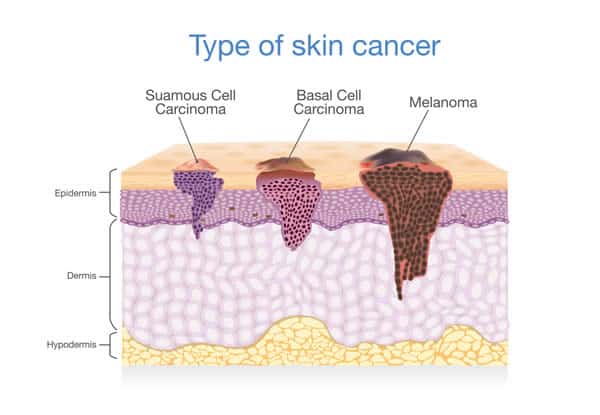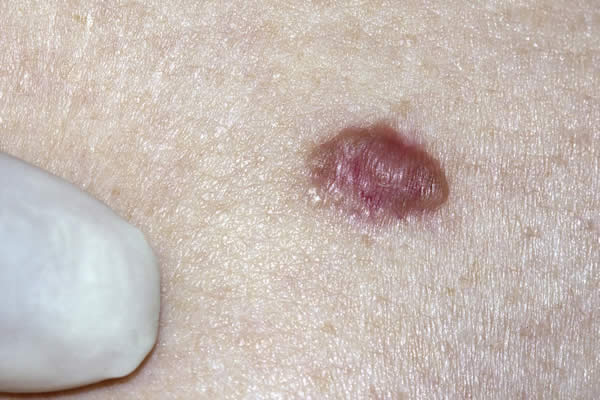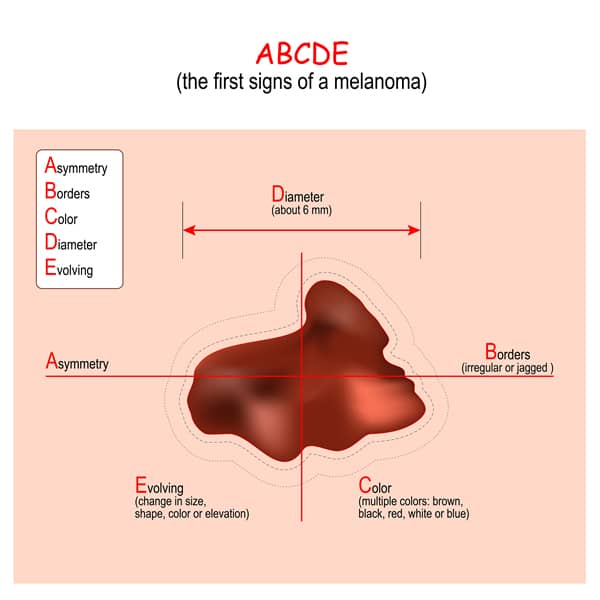May is Skin Cancer Awareness Month. Increase your knowledge (and awareness) of skin cancer types, warning signs, symptoms, and—perhaps most importantly—how to reduce your risk of developing this type of condition.
3 Most Common Types of Skin Cancer
While there are several different skin cancer types, the American Academy of Dermatology Association reports that the three most common are: (1)
- Basal cell carcinoma. This type of skin cancer is often due to spending a lot of time in the sun or a tanning bed or booth. While it can appear on any area of the body, basal cell carcinoma is more frequently located on the head, neck, and arms. If left untreated, it can damage the nerves and bones, even potentially causing disfigurement.
- Squamous cell carcinoma. This skin cancer type also tends to develop on areas of the body with more sun exposure, which includes the face, neck, and ears, as well as the arms, chest, and back. Dry, scaly spots on the skin (called actinic keratoses) can turn into squamous cell carcinoma. Like basal cell carcinoma, this skin cancer can grow deep, leading to damage and disfigurement.
- Melanoma. Because melanoma often spreads, it is considered the most serious type of skin cancer you can get. Diagnosing this cancer early is critical, enabling you to also get early treatment.

Other types of skin cancer include Merkel cell carcinoma, skin lymphoma, and Kaposi sarcoma. While rarer (2), it is possible to develop one of these conditions, requiring the need for treatment.
What Skin Cancer Looks Like
The Skin Cancer Foundation recommends getting your skin checked once per year by a dermatologist. (3) However, it is also helpful to regularly check your skin yourself to see if you notice any differences or potential problem areas.
What are you looking for?
The early stages of skin cancer can look like a bump, rash, or uneven patch of skin. Other things to watch for can vary based on skin cancer type. (1)
For instance, basal cell carcinoma is often a spot that is pearl-like, pink, or even a fleshy color.

Squamous cell carcinoma can be a scaly patch or it might be a firm red bump. A sore that re-opens after healing can also be squamous cell carcinoma. As mentioned, actinic keratoses can turn into squamous cell carcinoma. So, you also want to watch for dry patches.
Melanoma generally looks like a mole that has changed. Although, it can sometimes appear as a new mole or dark spot that wasn’t there before.
One way to easily remember the warning signs or symptoms of skin cancer is with “the ABCDEs of melanoma,” which are: (4)
- A – asymmetry: if one side of the spot in question is different from the other
- B – border: if the border of the spot is uneven or notched
- C – color: if the spot has numerous colors, variations of the same color, or changes in color as it grows
- D – diameter or dark: if the spot is as large or larger than a pencil eraser, or if it is darker than your other spots
- E – evolving: if the spot changes in any way, including if it starts to bleed, itch, or crust over

How Skin Cancer is Diagnosed
Should you notice a spot that may be skin cancer, making an appointment with a dermatologist or your primary care provider is the next step. They may remove all or part of the spot and biopsy it to learn if it is cancerous (if they are concerned about its appearance or changes).
If the biopsy reveals that you do have skin cancer, your healthcare provider will likely want to determine which stage it is in (there are five stages in total). Tests used to determine the stage of this skin cancer type include CT and PET scans, chest x-rays, and ultrasounds. (5)
Skin Cancer Treatment Options
Depending on the skin cancer type and stage, recommended treatment options can vary. The eight standard treatments for skin cancer are: (5)
- drug therapy
- chemical peels
- surgery
- radiation
- chemotherapy
- immunotherapy
- targeted therapy
- photodynamic therapy (which combines light therapy with drugs designed to destroy cancer cells)
How to Protect Yourself from Skin Cancer
Perhaps the best reason to increase your skin cancer awareness is to learn the actions you can take to prevent it. Recommendations issued by the Centers for Disease Control and Prevention (CDC) include: (6)
- wear clothing and gear to protect your skin from the sun
- stay in the shade when you can
- use a broad-spectrum sunscreen with an SPF of 15 or higher
- don’t use indoor tanning beds and booths
It may also be beneficial to take a dietary supplement. For example, studies have found that vitamin D seems to help protect against skin cancer. (7) Vitamin A also appears to have the same effect. (8) Natural Wellness offers a product called Hair, Skin & Nails, which contains several vitamins and minerals designed to help support skin health.




